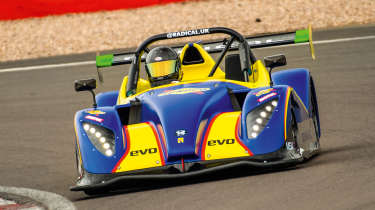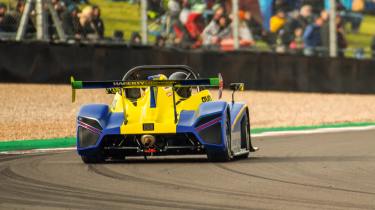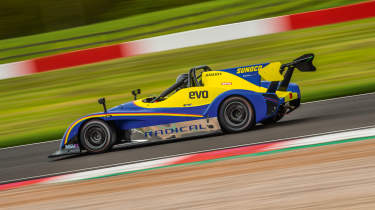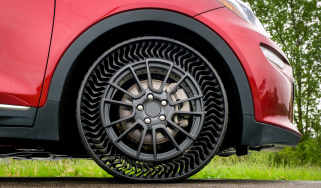Radical SR1 XXR 2024 review – testing (and racing) Radical's entry-level prototype
Radical’s entry-level racing car has been re-released in enhanced XXR guise. We try it for size – by racing it
‘What’s the best car you’ve ever driven?’ is the question every automotive journalist gets asked the most. I’ve never come up with a good answer; like everything in life, it’s all relative. But the most fun car I’ve ever driven: that one’s easy. In 2016 I raced a season in a Radical SR1, the Peterborough track car company’s entry-level racing car. It felt as if it spliced the genes of a kart with a three-quarter-scale prototype racer. I’ve never experienced another car so immediate, so controllable and so thrilling.
That was the original SR1, launched in 2012. It was comprehensively updated in 2017 and, now, this is its third generation: the new Radical SR1 XXR was introduced halfway through 2023, with fresh electronics, revised aerodynamics (including an LMP-style central dorsal fin) and the fifth generation of Radical’s 1340cc engine. Like before, it’s based on Suzuki’s Hayabusa motorcycle engine but rebuilt by Radical’s RPE engine division. Compared with the older SR1, the Gen 5 engine is designed to last longer (with 80 hours between rebuilds) and features a new engine management system, drive-by-wire electronics and a revised exhaust system.
To my eyes it’s a more attractive car than before. The original SR1 was adapted from the Radical SR4 released in the mid-noughties, with styling inspired by the Bentley Speed 8 Le Mans car. The redesigned bodywork is more contemporary in style and looks great in this car’s Porsche 917 Can Am-aping livery. It’s still a tiny car, less than 3.9m long and only just over 1m high.
More reviews
Group tests
- Lotus Emira Turbo SE v Alpine A110 GTS – two of the last surviving mid-engined sports cars
- Alpine A290 v Alpine A110 – how much DNA do they really share?
- Ariel Atom 4R v Caterham Seven ‘evo25’: power-to-weight heroes go head-to-head
- Ariel Atom 4 v Caterham Seven 310R v Lotus Elise Cup 250
- £200,000 supercar shoot-out: AMG v Aston Martin v Maserati v McLaren
- Audi Quattro, RS2 and RS3: five-cylinder icons head-to-head
- Who makes the best GT car? Aston Martin v Bentley v Maserati
- Caterham Super Seven 600 v Super Seven 2000
- Corvette Stingray v Porsche Cayman GTS v Audi R8 RWD
- Great Ferrari hypercars driven: 288 GTO, F40, F50 and Enzo head-to-head
In-depth reviews
- Abarth 600e 2025 review – Italy gives the Alpine A290 something to worry about
- Alpine A110 review – the sports car Lotus should be building
- Aston Martin Vantage 2025 review – a thrilling Mercedes-AMG GT and 911 Turbo S alternative
- Audi R8 (2015 - 2024) review – the ultimate soft-focus supercar
- BMW iX 2025 review – the ugly duckling still stomps the Tesla Model X
Long term tests
- Abarth 695C Turismo Fast Fleet test – living with the charming Italian hatch
- Alfa Romeo Giulia Veloce long term test – can Italy beat Germany?
- Alpina B10: Alpina B10: end of term report
- Aston Martin Vantage (2006) Fast Fleet test – living with a £30k V8 Aston
- Caterham Seven evo25 Fast Fleet test – living with a track car for the road
- Caterham Seven evo Edition revealed – bespoke 420R joins the Fast Fleet
- Cupra Leon 300 Fast Fleet test – living with Spain's 300bhp hot hatch
- Cupra Ateca VZN Fast Fleet test – four months with Cupra's hot crossover
- Cupra Leon Estate 310 4Drive Fast Fleet test – living with the 306bhp hot estate
- Ford Mustang GT
Review
- New Bentley Batur 2023 review – can it possibly be worth £1.65m?
- 2023 Chevrolet Corvette C8 Z06 review – the American 911 GT3?
- BBR Supercharged Mazda MX-5 (ND) 2023 review – tuned 250bhp roadster driven
- MG4 Trophy 2023 review
Reviews
- Abarth 695 75 Anniversario edition 2024 review – a fitting send-off for Abarth’s hot supermini?
- Abarth 500e 2023 review
- AC Cobra 378 Superblower MkIV 2021 review – another V8 Cobra, but with a GM heart this time
- Acura Integra Type S 2024 review – a Honda Civic Type R with added restraint
- Alfa Romeo Giulia review – get one while you still can
- Alfa Romeo 33 Stradale 2025 review – a rare Italian jewel beyond compare
- Alfa Romeo SZ: history, review and specs of an icon
Settling into its lay-back driving position, the interior is neater than before too, with all the control switches integrated into a panel on the dash. It’s much like its bigger brother, the impressive SR3 XXR we tried in evo’s 2024 Track Car of the Year test. It’s a user-friendly, clearly laid-out cockpit, and the engine starts at a simple push of a button. Where the original SR1’s six-speed sequential gearbox was manual as standard or an electro-pneumatic paddle-shift as an option, now it’s paddles only. You stay flat on the throttle for upshifts and an autoblip system means there’s no chance of locking the rears in the wet.
Rather than an individual track test, we’re experiencing the SR1 XXR in the most immersive way possible: by racing it, with a one-off return to the opening round of the SR1 Cup, Radical’s dedicated race series for the car.
Eight years ago when I last experienced the SR1 Cup, it was open only to novice drivers, with their licence test, a race suit and two introductory test days all integrated into the price of the car. Drivers were allowed to race in the Cup for two seasons, before moving on. Now, drivers of all experience levels can enter but the SR1 Cup is still positioned as the first stepping stone on the Radical ladder. Previous champions include James Pinkerton, who is now head of R&D at Radical itself and Darryl de Leon, who is now racing in the British Touring Car Championship. (And, erm, me, somewhat less notably.
Nowadays, the SR1 Cup runs as a separate class within the wider Radical Cup, sharing the grid with the faster Radical SR3 category (bigger engine, wider dimensions, more downforce, slick tyres). Many races are on the support card for the BTCC, with live coverage on TV and big crowds to race in front of.
Happily there are fewer crowds for practice, as I brush off eight years of rust since last driving the SR1. It feels really quite different from my memories of the Gen 1 car. It even sounds different: a lower, gruffer engine note to the old car’s banshee shriek. The original SR1 didn’t know the meaning of the word understeer, and was a car in which you were constantly managing oversteer – which was one of the facets which made it so much fun, but also mentally draining over a race distance. The new car is much more stable at the rear and planted generally. In fact, I find myself chasing understeer in practice and Radical’s factory team quickly work out a set-up to neutralise it. The SR1’s suspension is fully adjustable, with interchangeable roll-bars.
One thing that hasn’t changed is that the SR1 is quite lively under braking, and you often arrive at corners with a fractional turn of opposite lock, a little like a kart. That’s partly because, as before, the SR1 races on long-lasting treaded tyres rather than slicks, for lower limits and reduced costs over a season.
I don’t get the best from the car in qualifying, lining up third on the grid behind British karting championship graduates Sam Shaw and Marcus Littlewood. The quickest SR1s can mix it with the slowest SR3s, so the two classes are separated into two, staggered rolling starts. I get a good reaction to the lights and manage to squeeze past Littlewood on the run to Redgate, emerging in second place. Several laps later we’re catching the Radical SR3 of Adrian Hallmark (yes that one, the outgoing Bentley/incoming Aston Martin boss, competing in his first ever race). Shaw dives down Hallmark’s inside at Redgate, and I stay to the outside, cutting back for a good exit. That brings me alongside Shaw on the plunging, flat-in-fifth run down Craner Curves – not a place I’d choose to go side by side but you take your opportunities when you can, and the SR1 is rock-steady stable in fast corners – and I’m through. When the chequered flag falls, I’m still in front. It’s my first win since 2016, and a ringing endorsement of the XXR’s user-friendliness.
That puts me on pole for Race Two, and this time I’m a little too cautious on the brakes into Redgate, allowing Shaw to sweep around the outside and into the lead. The safety car comes out for an incident in the SR3 class upstream, and at the restart I manage to get a double-slipstream from both Shaw and Hallmark ahead (thanks, Adrian), allowing me to slot between the two cars and into the class lead. I put another SR3 between Sam and I later in the lap for some more breathing space and I’m the first SR1 over the line at race-end.
I’m pretty happy, of course, but leaving emotion to one side, the new car is definitely a marked step on from the original in terms of user-friendliness and stability. It feels a more cohesive and well-rounded product, but it still has the same kart-like purity to its driving characteristics.
Like everything in life, the SR1 has become more expensive in the last eight years. The XXR costs £65,460 and running costs for a season vary; some competitors run the car themselves, others pay for teams to run the car. Some customers don’t race the car at all and use it purely for trackdays; and some are bought by racing schools, particularly in the USA.
Actually, I’d say the more tail-happy, shrieking-revs-soundtracked original is slightly more exciting to drive – but the XXR is unquestionably a better car. The answer to the question is still the same: the Radical SR1 is still the most fun car I’ve ever driven, and now it’s an even better car than before.
Radical SR1 XXR specs
| Engine | In-line 4-cyl, 1340cc |
| Power | 188bhp @ 9150rpm |
| Torque | 115lb ft @ 7250rpm |
| Weight | 510kg (375bhp/ton) |
| Tyres | Hankook treaded race tyres |
| 0-62mph | c3.0sec |
| Top speed | c140mph |
| Basic price | £65,460 |






